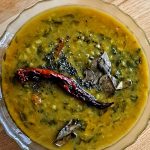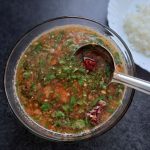Rasam

Rasam, often hailed as the “King of South Indian Soups,” is a traditional, tangy, spicy soup that holds a special place in Southern India. Rasam’s digestive properties make it a staple in celebratory events, including wedding feasts, where it serves as a flavorful aid to digestion. Rasam is a comfort food, often prepared at home during illnesses or times of discomfort. Its unique blend of spices, tamarind, and a medley of herbs makes it a go-to remedy for colds, fevers, and digestive issues. This flavorful soup seamlessly transitions from healing in times of illness to a celebratory companion. With its roots deeply embedded in South Indian cuisine, Rasam has transcended regional boundaries to become a beloved dish enjoyed by many across the globe.
Many of the ingredients in Rasam, such as garlic, black pepper and cumin, are believed to have various health benefits. These include antimicrobial properties, immune system support, help in digestion and potential relief from common cold and respiratory issues. The combination of tamarind, black pepper, cumin, and other spices not only imparts a distinctive flavour but also aids digestion.
You can adapt the basic recipe by varying the spice levels, choosing different herbs, and adding ingredients such as tomatoes, garlic, or lentils. Here’s a basic recipe for traditional South Indian Rasam.



Rasam
Ingredients
1 cup = 250ml
- 1 tbsp peppercorns
- 1 tbsp cumin
- 4 cloves of garlic
- 2 crushed tomatoes
- ¼ tsp turmeric powder
- 1 small lemon-sized tamarind ball soaked in half cup water
- 2 tbsp oil
- 1 tsp mustard
- 2 dry red chillies
- A pinch of asafoetida hing
- Few curry leaves
- Fresh coriander leaves chopped, for garnish
- Salt
- 3 cups of water or as needed
Instructions
- Extract tamarind juice from the soaked tamarind ball by squeezing it in water. Strain to remove any solids.
- In a blender, combine cumin seeds, and black peppercorns and crush it in pulse mode.
- Add the garlic cloves crush it again in pulse mode and keep it aside.
- In a separate pot, heat oil. Add mustard seeds and let them splutter. Add dry red chillies, curry leaves, and asafoetida.
- Mix in the crushed spice from the blender, add turmeric and salt. Saute for a few seconds.
- Crush the tomatoes in a blender and add to this. Saute for a minute.
- Pour the tamarind extract, water and chopped coriander leaves.
- Allow the rasam to simmer on low heat for about 5-7 minutes. Be careful not to boil it excessively. Turn off the flame when it reaches the boiling point.
- Serve hot over steamed rice or as a soup.
Notes

1 thought on “Rasam”